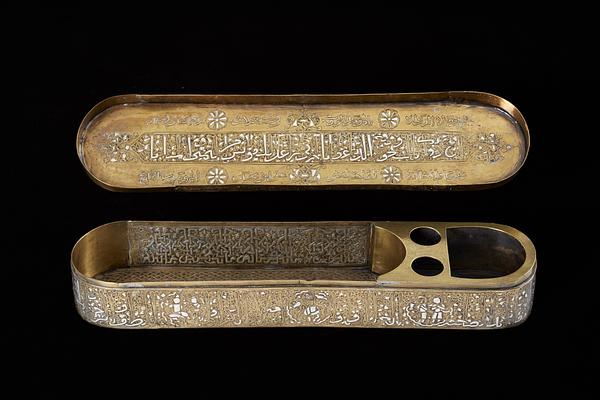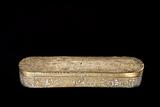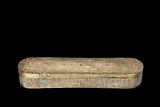Pen case, brass, engraved and inlaid with silver
Iraq, Mosul; 653 H = 1255-1256
H: 5.7; L: 36.3; W: 7.5 cm
In the first half of the 13th century, Mosul was the most famous center in the western Islamic world for the manufacture of brass objects inlaid with gold and silver. The city’s artists settled throughout the Middle East, where the nisba al-Mawsili (“from Mosul”) was a guarantee of quality.
The inscription in the lid gives us e.g. the following information: “This pen case was made in Mosul – The Protected – in the year 653 … Engraved by Ali ibn Yahya al-Mawsili that same year.” Apart from a ewer in the British Museum, this is the only other work of art that can be traced to Mosul itself through an inscription. The pen case is worn and was restored in modern times, but the remnants of the finely engraved ornamentation still bear witness to its high quality.
Inv. no. 6/1997
Published in:
Kjeld von Folsach: Art from the World of Islam in The David Collection, Copenhagen 2001, cat. 506;
Almut v. Gladiss (ed.): Die Dschazira: Kulturlandschaft zwischen Euphrat und Tigris, Museum für Islamische Kunst, Berlin 2006, cat. 28, pp. 73-74;
Julian Raby: “The principle of parsimony and the problem of the 'Mosul school of metalwork'” in Venetia Porter and Mariam Rosser-Owens (eds.): Metalwork and material culture in the Islamic world : art, craft and text : essays presented to James W. Allan, London 2012, pp. 23, 32 and note 61 (no photo);
Frédéric Bauden: ”‘The Calligrapher is an Ape!’: Arabic epigrams on pen boxes (sixth/twelfth–ninth/fifteenth Centuries)”, in Bernard O’Kane, A. C. S. Peacock and Mark Muehlhaeusler (eds.): Inscriptions of the medieval Islamic world, Edinburgh 2023, fig. 16.8, pp. 501-502;
Joachim Meyer, Rasmus Bech Olsen and Peter Wandel: Beyond words: calligraphy from the World of Islam, The David Collection, Copenhagen 2024, cat. 38, pp. 174-175;



